Description and cultivation of Japanese honeysuckle
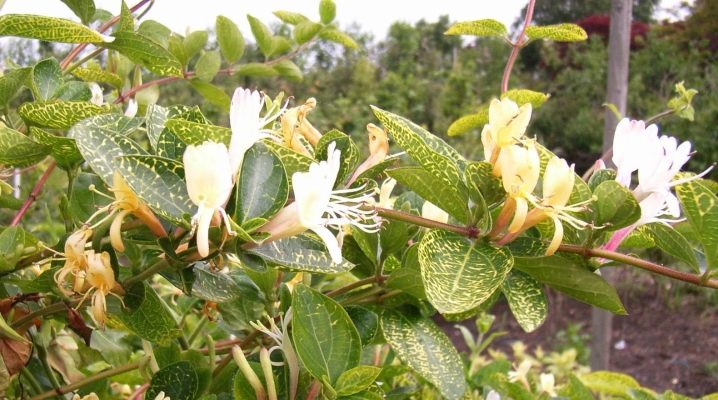
Japanese honeysuckle presents an attractive picture. This is a Japanese-style graceful plant with interesting flowers that can completely hide a hedge or wall. The plant is spectacular, and caring for and growing it is not difficult.
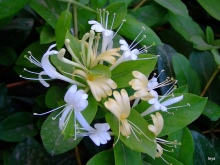
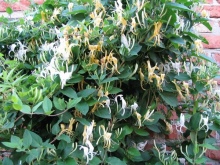
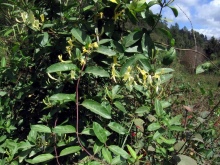
general description
Japanese honeysuckle is native to Asia. The plant was originally widespread in Japan and Korea. Now it is actively used in landscape design all over the world.
This is a graceful evergreen or semi-evergreen liana, with medium-sized ovoid leaves, smooth, medium or light green. Scourges can be up to 10 m long. Flowers are white-yellow, flying, with narrow petals and lush anthers. Flowers are arranged in pairs, have a bright aroma.
The plant blooms quickly, in the 2nd year after planting. Round black berries appear in place of flowers in October-November.
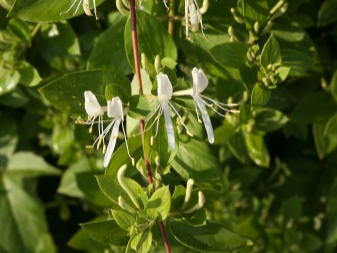

There are many varieties and varieties of Japanese honeysuckle.
- Haliana. A well-known variety and the most widespread in Russia. A plant with white-yellow flowers up to 10 cm in diameter, up to 7 meters high, very unpretentious. Blooms in early summer, flowering can last until late autumn. It grows by 1.5 meters per year.
- "Variegated". The leaves are green, but with a creamy border around the edge. The flowers are fragrant, milky in color, the fruits are inedible, purple. The plant is vigorous, it can reach a height of more than 10 meters. The variety is quite rare. The requirements for care are increased - the plant does not like stagnant moisture, lack of sun.
- "Aureoreticulata". Semi-evergreen. Has a golden pattern on the leaves. The background is dark green, the veins are bright, golden yellow. Height - up to 2-4 m, annual growth - half a meter. The flowers are white, but as they mature, they acquire a honey tint. The aroma is exciting, very strong. It blooms unstably. A very spectacular variety, looks great even without flowers. But more capricious than Haliana. In the conditions of the Russian Federation, it is grown either in the southern regions and the central regions adjacent to them, or with shelter for the winter. Well suited for conservatories or patios. For planting, you need the most fertile soil and a well-lit area.
- Red World. It is a red-flowered variety of Japanese honeysuckle. Semi-evergreen honeysuckle that retires in February and wakes up in April. Growth potential - up to 6 m. The foliage is beautiful, dark green, with yellow veins. But the main advantage of the plant is its bright red flowers, very abundant. The aroma is there, but weak, the fruits are good for food.
- "Honey Liana". The owner of amber-yellow, bright flowers that stand out very beautifully against the background of large, dark green foliage. It grows up to 6 meters, giving an increase of half a meter every year.
- Purpurea. An evergreen plant with bright green foliage, which darkens in summer and turns purple by autumn, with a clear maroon edging around the edge. Height - up to 4 m. The flowers are white-red, over time, the white petals acquire a yellow tint. The aroma is strong, the berries are inedible.
- Halls Prolific. This is a compact liana, no higher than 2.5 meters. It blooms with small but very abundant white-yellow flowers. A very lush plant that gives a lot of shoots from the roots. Blooms late for honeysuckle - in June. This is one of the best species for compact hedges - the plant has a dense bush, excellent growth vigor, it tolerates a haircut perfectly, and blooms very profusely.


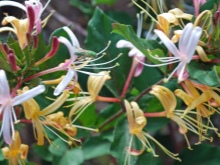
Japanese honeysuckle is unpretentious, withstands frosts down to -35 ° C, frost resistance zone - 4a, in Crimea it manages to bear fruit, and in more northern regions it may not bloom every year. Unfortunately, in the middle lane, Japanese honeysuckle is too demanding, so honeysuckle honeysuckle is planted in the open field. It is not inferior to the Japanese in splendor, but more winter-hardy.
If you want to grow exactly Japanese, it is better to use it as a houseplant or a crop for winter gardens.
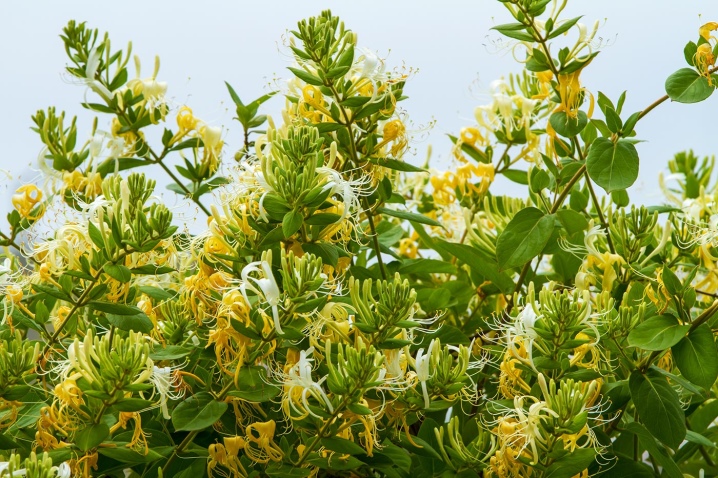
Landing
Honeysuckle can be planted in any soil, the plant is not capricious. However, the best choice is a loose, nutritious soil that is well permeable to moisture and air. Loam is optimal by type, too clay and sandy soils are not the best options. In heavy soils, add several buckets of sand per 1 sq. m. In places with stagnant moisture, good drainage is required.
The place is chosen according to need: honeysuckle is often used to hide ugly fences or old walls. The plant is well suited for planting on slopes - it strengthens the soil. Honeysuckle is also grown in container culture.
For "Variegated" and "Aureoreticulata" it is better to choose the southern, southeastern and west-eastern sides of various supports. "Aureoreticulata" in good lighting becomes even brighter, the picture is more contrasting.
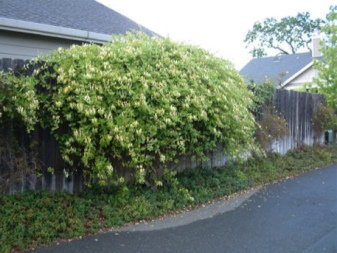
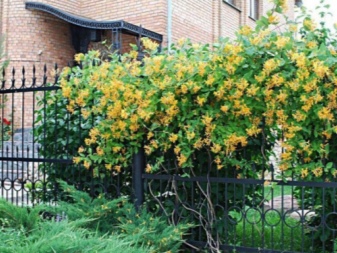
The supports must be stable, the plant is gaining a fairly large mass.
The soil in the area for honeysuckle should have a neutral or slightly acidic pH. Seedlings are planted in holes 50 cm deep and 50 cm in diameter, sand is poured, 2 buckets of compost are poured, 1 glass of sifted ash and 1 tbsp. spoon of superphosphate, loosen well and sprinkle with a layer of ordinary soil. Then the seedling is placed so that the root collar is above the ground, and the roots begin to fall asleep. The soil is compacted, watered abundantly.
The best planting dates are autumn, from August 20 to September 15. You can plant it in the spring, but the sap flow begins too early. Even in warm regions of the Russian Federation, the soil does not have time to warm up before the buds begin to awaken, and planting after this event is guaranteed to destroy the seedling. In some areas, it can be planted in spring, the condition of the soil allows, but the time for rooting and a set of green mass is still too short. Therefore, an autumn planting is preferable. The plant will have time to take root and retire, the shelter will protect it from frost.
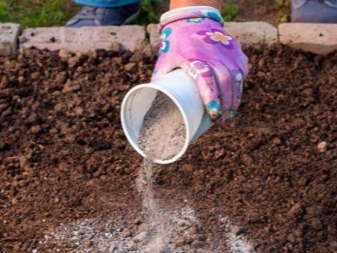

Care
The vine needs to be guided and trimmed. If this is neglected, the plant will quickly take on a messy, tangled appearance. The plant is active, has a powerful shoot-forming ability. Pruning is carried out in the spring, but only after the first leaves appear, otherwise it is impossible to determine the state of the shoot, the honeysuckle buds are hidden. Remove all frozen, old, broken and interfering branches.
If the plant was planted last year, then for better branching next spring, the shoots are cut off by 30 cm.
Routine maintenance consists of watering, removing weeds and loosening the soil. Watering is necessary only in hot periods, spending 20-25 liters of water per plant. Usually watered no more than 2-3 times per summer. However, it is necessary to monitor the condition of the soil individually, especially if the plant is young. If the soil is dry for the first 2-3 cm, it's time to water. Overflows are not allowed. The plant does not like drying out, however, an excess of stagnant moisture will be perceived even more painfully, up to rotting of the root and death of the bush.
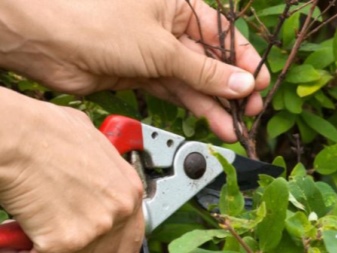
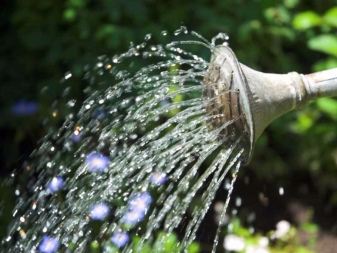
There is no need to feed in the first 2 years after planting, the plant will have enough nutrition from the soil, and more mature plants are fed. Flowering will become even more spectacular. In the spring, urea and organic matter are introduced, in the fall they fertilize with a complex fertilizer containing potassium and phosphorus.
In autumn, garbage and foliage are removed around the plants, the soil is mulched with clean straw or sawdust. If the winters are cold, you can cover it with spruce branches.
For the winter, heat-loving lianas are laid on the soil, on which wooden boards have been laid in advance, pressed and covered.
The shelter is removed no earlier than mid-April. They do this carefully so as not to burn the shoots that have become unaccustomed from it with the bright sun. It is better to shoot the shelter on cloudy days, in the evening.
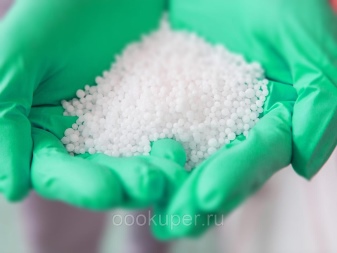
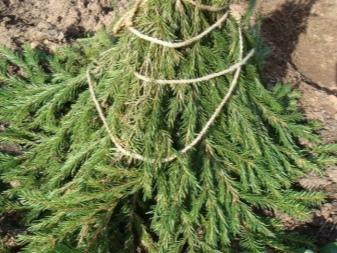
Reproduction
The plant propagates easily, in some countries Japanese honeysuckle has run wild and has become a weed. In the United States, it is considered dangerous for planting grapes, because it is the host plant of the causative agent of Pierce disease.
Propagated by seeds and vegetatively. Sowing seeds - in autumn, in open ground, to a depth of 1 cm. When planting in spring, seeds should be pre-stratified for several weeks.
It reproduces successfully by layering.
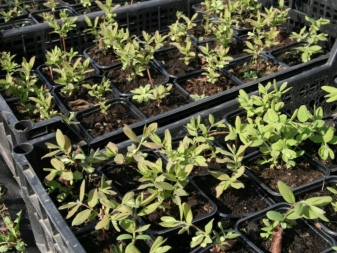

Diseases and pests
The plant is not susceptible to diseases and does not suffer from pests. Problems are possible only if care is neglected, or the plant is planted in the wrong climate. The plant can be formed as green screens, hedges, as single bushes. Looks great with roses or conifers.
It will help to realize creative ideas: for example, you can use Japanese honeysuckle for a shrub lawn, to fill gaps in landscape compositions.
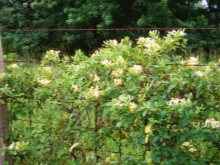
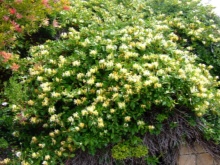











The comment was sent successfully.